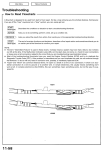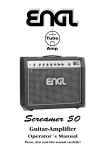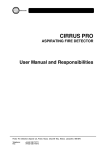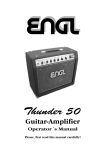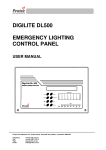Download Isolation Cabinet for Guitar User Manual
Transcript
Isolation Cabinet for Guitar Congratulations and thank you for purchasing the AxeTrak® PRO Isolation Cabinet for Guitar. We have gone to great lengths to insure that you are purchasing a high quality piece of professional studio equipment. The AxeTrak® PRO will last an extremely long time if used correctly. Please be sure to read through this manual carefully, as it contains important information on the performance and operation of your new AxeTrak®. This will help to ensure proper connection and safety precautions necessary for safe operation of this device. LIMITED WARRANTY Your AxeTrak® product is guaranteed against failure for 90 days. JLH Technologies, LLC will service and supply all parts at no charge to the customer providing the unit is under warranty. Shipping costs are the responsibility of the customer. This warranty does not cover, and no liability is assumed, for damage due to: natural disasters, accidents, abuse, loss of parts, lack of reasonable care, incorrect use, or failure to follow instructions. This warranty is in lieu of all other warranties, expressed or implied. No representative or person is authorized to represent or assume liability for JLH Technologies, LLC in connection with the sale or servicing of this product. JLH Technologies, LLC shall not be liable for incidental or consequential damages. When returning merchandise to the factory, you must call or email our office for a return authorization number. Describe in writing each problem. If your unit is out of warranty, you will be charged the current flat rate for parts and labor to bring your unit back to factory specifications. Contact 949-859-7293 or email us at [email protected]. You must register your product online at www.axetrak.com to validate your warranty. Contents of AxeTrak® should include: • AxeTrak® Isolation Cabinet for Guitar • User Manual • Two additional - Fast Acting, Fuses User Manual CAUTION: DO NOT ATTEMPT TO OPEN THE AXETRAK® AS IT MAY SERIOUSLY HURT THE SOUND CHARACTERISTICS OF THIS DEVICE AND WILL VOID THE WARRANTY. THE AXETRAK® IS ASSEMBLED WITH VERY TIGHT TOLERANCES SO THAT IT DOES NOT CREATE ANY UNWANTED RESONANCES. DO NOT USE THIS DEVICE IN ANY WAY OTHER THAN DESCRIBED IN THIS MANUAL. “PRO” MODEL Revised March 2014 1 The AxeTrak® is a very useful piece of professional studio equipment. It will make recording guitar tracks as easy as one... two… three. DIRECTIONS FOR USE With your guitar amplifier turned off, connect all of the pedals and processors that you would normally use for “Your Sound” to your amplifier. Connect them the same way you would for your live sound. Connect a speaker cable from the speaker jack of your amplifier to the “IN” jack on the AxeTrak®. Always make sure that your guitar amplifier can safely drive the input impedance of your particular AxeTrak® unit. If you are using a tube amplifier, adjust the speaker output impedance selector on your amp to match the input impedance of your AxeTrak. The volume on your guitar amplifier should be turned all the way down initially. Insert a low impedance microphone cable into the XLR jack on the front of the AxeTrak®. Plug the other end of the microphone cable into your recording console, computer sound card, preamp or mixing board. Do NOT use phantom power on this device. If you are plugging the AxeTrak® into a high impedance ¼ inch jack, you will need to use an impedance matching transformer as shown in the diagram below. This is a very critical point; you do not want to needlessly crank high power amps to extreme levels beyond this point or you will blow the fuse. If you use a distortion or overdrive pedal, set the volume and gain on your pedal the same way you would for a live performance. Slowly turn up the master volume on your guitar amp until the input LED on the AxeTrak® BEGINS TO GLOW BRIGHTLY. To record clean tones adjust your guitar amp as follows: With your guitar amp turned off, adjust the gain and channel volume as you would to produce a clean sound. Turn the master volume on your amp all the way down. Connect a speaker cable from the speaker jack of your amplifier to the “IN” jack on the AxeTrak®. Now turn on your amp and slowly turn up the master volume until the level LED on the AxeTrak® JUST BEGINS TO FLICKER. Removing the “Deep Plug” will further improve the cleanrecorded tone of this device and allow it to move more air. If the AxeTrak® does not make any audible sound, turn off your amp immediately and check the fuse. The AxeTrak® is fuse protected to protect the internal components. In the event that you blow the fuse on your AxeTrak®, it should ONLY be replaced with the same type fuse and with the same current rating. See below: For 8 ohm AxeTrak For 16 ohm AxeTrak For 4 ohm AxeTrak - For recording overdriven guitar tones the preamp gain on your guitar amplifier should be cranked so that your amplifier is producing a smooth distorted or overdriven signal. The master volume should be turned up very slowly until the input LED of the AxeTrak® BEGINS TO GLOW BRIGHTLY. The AxeTrak® is NOT designed to handle high gain amplifiers cranked at full volume like a power attenuator. 2 2.5A or 3A/250 3AG fast acting fuse. 1.75A or 2A/250 3AG fast acting fuse 4A /250 3AG fast acting fuse. UNDERSTANDING THIS DEVICE The input on the AxeTrak® is a standard ¼ “ phone jack which makes it easy to connect to the speaker output jack on most professional guitar amps. The input jack drives the custom driver as well as the signal level LED. The sound is converted into an electrical signal with the use of a dynamic cardioid microphone cartridge, which has been carefully selected and modified exclusively for this device. This cartridge is meticulously mounted on our new microphone mounting assembly, which allows for 100 degrees of microphone rotation. The cartridge is then wired to the XLR jack mounted on the front of the AxeTrak. There is no ground connection on the balanced XLR output of the AxeTrak® so there is no possibility of noise being created from ground loops when using this device. The AxeTrak® uses a normal low impedance microphone cable so that it can be used in the studio as well as on stage where long cables are often necessary for running sound. If you wish to plug the output of your AxeTrak® into a high impedance input source (one that uses a ¼” input jack instead of the regular XLR input), you will need to purchase an impedance matching transformer as shown in the setup diagram on page two. 3 Our unit is designed to work well either way. If you do use an impedance matching transformer you will probably notice that the extreme low-end bass response is reduced. This is due to the nature and characteristics of coils and transformers. For overdriven guitar tones the AxeTrak® is designed to sound its best when your guitar amplifier is set to a level that makes the input LED on the AxeTrak® begin to glow brightly. You do not want to needlessly crank your amp much beyond this level. MICROPHONE ADJUSTMENT SCREW REAR OF UNIT – REAR OF UNIT REAR OF UNIT 25° Before On Axis On Axis 75° Beyond On Axis Top of unit Top of unit Top of unit FRONT OF UNIT FRONT OF UNIT FRONT OF UNIT MICROPHONE ADJUSTMENT SCREW - The new microphone mounting assembly of the AxeTrak® PRO allows for 100 degrees of microphone rotation adjustment and unlimited recording options. The microphone adjustment screw is located on the top of the unit, on the left side of the strap handle. PLEASE BE AWARE THAT THIS SCREW SHOULD ONLY BE TURNED WITH A SMALL OBJECT LIKE A PENNY, DIME OR QUARTER. If this screw is turned to tightly it will compromise the adjustment capabilities of the assembly and the unit will need to be sent to the factory for service. PLEASE ALSO BE AWARE THAT THIS SCREW IS ONLY DESIGNED TO TURN APPROXIMATELY 90 DEGREES. If you want to record a bright clean guitar tone, you might start with the microphone direct “On Axis”. If you want to record high gain guitar tracks you might start with the microphone just slightly past “On Axis”. This happens to be our favorite setting. This will give a slightly darker and smoother rounded tone. Of course you can adjust the microphone adjustment screw anywhere in between for your own personal recording preference. 4 BASS BOOST SWITCH - This switch is located on the left side of the dual toggle switch. It is identified with a green dot in the upward position. When the green dot is pushed you will significantly boost the low-end frequencies coming from the unit. For the cleanest guitar tones you do not want to engage this switch. This switch is great for getting that deep chug sound, for guitarist that tune down or play 7 string guitar, and jazz players that like a full deep tone. TREBLE BOOST SWITCH - This switch is located on the right side of the dual toggle switch. It is identified with a red dot in the upward position. When the red dot is pushed you will significantly boost the highend frequencies coming from the unit. For the cleanest guitar tones you may want to engage this switch. This switch is great for getting that pristine, spanky clean, single coil sound. DEEP PLUG - If your particular style of music requires deep subsonic bass tones, you can unscrew the circular “Deep Plug” located on the left side of this device. Simply insert a quarter or small angle bracket in the slot and turn counterclockwise to remove. Do not over tighten this plug as it has a flared thread. It only needs to be slightly snug and it will not rattle or resonate audibly. SPECIFICATIONS Input Impedance 8 Ohms Standard (16 ohms and 4 ohms also available) Output Impedance Low Impedance 200 – 600 Ohms (Mic level) Wattage Rating 75 Watts RMS (fuse protected) Dimensions Height 11” (279 mm) Width 10.5” (267 mm) Length 13.25” (337 mm) Weight 20 lbs (9.5 kg) Power Requirements None For product registration please go to www.axetrak.com and click on Register Product 5



